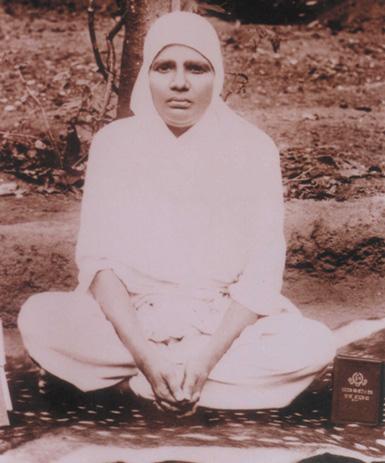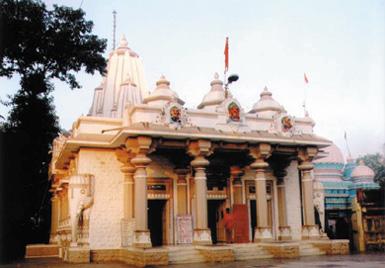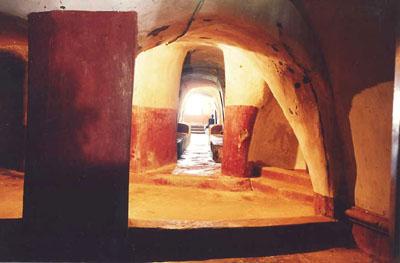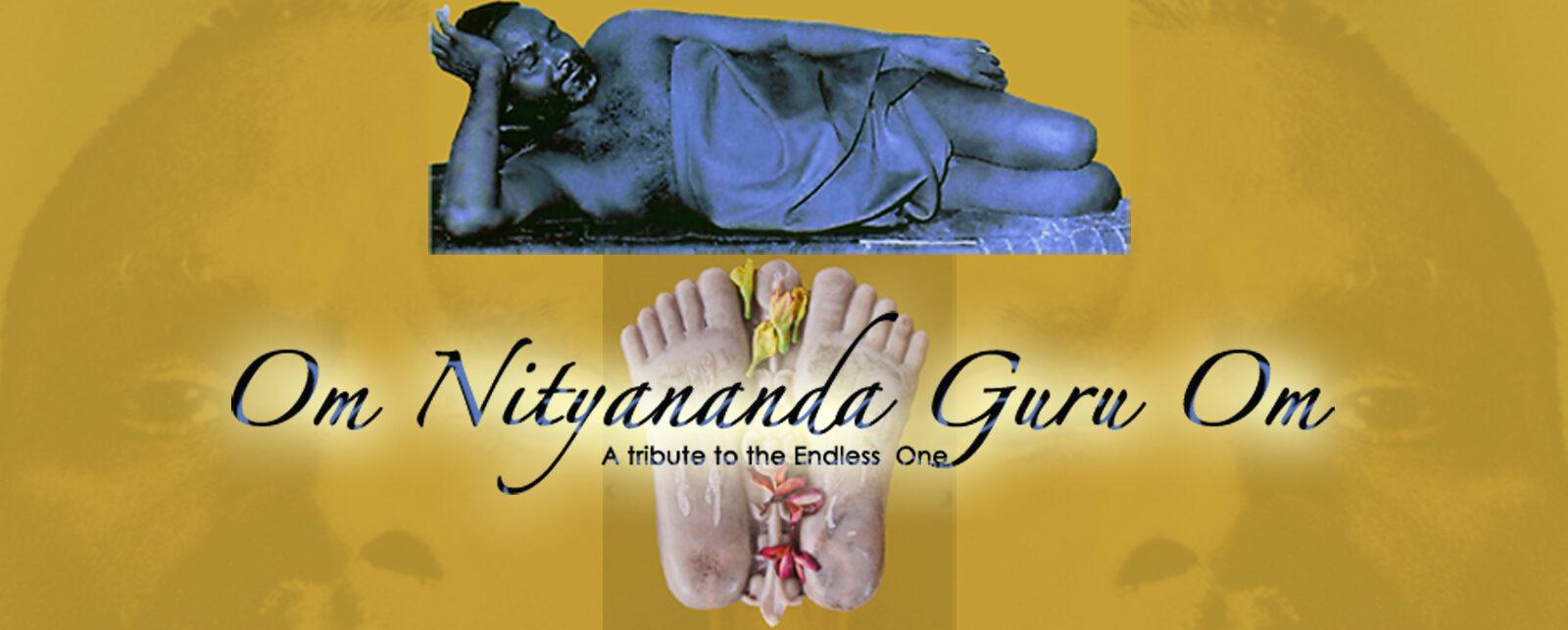
TULSI AMMA

Tulsi Amma, Divine Mother.
Of all the disciples of Bhagawan Nityananda, Tulsi Amma was a class apart. Bhagawan Nityananda himself declared her to be “One who has seen the Sun,” meaning that she had realized the eternal Bliss of the Absolute, that she had gone across. If this is how Bade Baba described her, any words that I use here pale in comparison. In our house, her photo has been kept for worship on our altar. It is Tulsi Amma who recorded Bhagawan Nityananda’s words whenever he spoke while in deep trance. These utterances were compiled in a book called the Chidakasha Gita. The name “Chidakasha Gita” was approved by Bade Baba and the book was originally written in Kanada. It is because of Tulsi Amma that we have the teachings of Bhagawan Nityananda available to us. The original Chidakasha Gita was translated into English, unedited, by Mr. Mangalore Sanjeeva Kamath of Mahim, Mumbai. He was a great devotee of Baba.
Very little is known about Tulsi Amma and those who know about her are no more. Although she wrote several books, she never mentioned her name as author of those books nor did she reveal anything about herself. I am sharing what I remember from the discussions that I heard from my elders, and from her book of Bhajans entitled Atmaspuran (inspiration from the soul).
Tulsi Amma was from Mangalore in South India and must have met Bhagawan Nityananda in early 1920. She was a young widow at the time. In those days life for a widow in India was very difficult and painful. In that pain she turned to God. She belonged to the community of Gowda Saraswati Brahmins and took to the monkhood. This enabled her to wear janava (holy thread) and perform Sandhya Vandana, the ritual usually only performed by Brahmin men. She wore a white sari as a widow is supposed to wear and she kept her head covered. She was fluent in the Konkani, Kanada and Marathi dialects.
Tulsi Amma was also known as Anandi. She met Swami Nityananda in Mangalore. Bhagawan Nityananda lived in the Avadoota state, completely absorbed in his own being. He lived a carefree life like a small child. It was often necessary to take care of him just as one takes care of a small child. Tulsi Amma had rented a house from Basti Shanbaug in Mangalore. Being a young widow, she had to lead a very austere life, as was the societal norm of the time. Meeting Bhagawan Nityananda caused a complete transformation in her. She became intensely devoted to Bhagawan Nityananda and, through her renunciation, attained the state of elated dispassion. By the Grace of her Guru, Bhagawan Nityananda, her intense devotion and surrender gave rise to the constant, uninterrupted experience of Supreme Love within her own being.

Tulsi Amma began to express her profound spiritual experiences by composing several Bhajans (devotional songs). These were compiled in her book, Atmaspuran. Bade Baba really appreciated these Bhajans. The Bhajans open with Gurustavan, a song-sermon to the glory of Bhagawan Nityananda that was recently recorded by Professor Kamath of Kanhangad. Rob and Sara Marvin traveled from the USA to engineer this recording which was videotaped with the Kanhangad holy caves in the background. This is the first time in recent memory that anyone has paid homage to Tulsi Amma for her contribution in bringing the teachings of Bhagawan Nityananda to us.
If you carefully observe in the video where a lotus is shown with the reflection of the Sun in a pond (outside the Kanhangad Ashram), you will see an image of Bade Baba. Actually it is the reflection of the sun in the pond which appears like Bhagawan Nityananda’s face. This CD created by the Marvins seems to be thus blessed by Bade Baba. In her Gurustavan, Tulsi Amma describes Bhagawan Nityananda as the eternal Bliss of the Absolute that is comparable to none. In her Bhajans she describes the practice and experience of Gurukripa, the way in which a disciple attracts the Guru’s Grace into his/her life through complete surrender and devotion to the Master.
Tulsi Amma suffered a great deal during her life. But she understood her suffering as her Karma from many past lives. In the pain of her suffering, she sought her Guru and developed unconditional love for him. Although she had to take many births to wash off the effects of her past Karma, she never compromised her love for her Guru. She asked only for Liberation, for her Nityananda’s state and never demanded relief from her suffering. Unconditional Love, Unconditional Surrender and non-attachment to pain or pleasure are some of the principles she spread through her own life. Her Bhajans were first published by Sri Ramkrishna Shenoy (brother of Sitaram) on March 7, 1940, on Mahashivaratri. They were reprinted on Gurupurnima day of 2000 by Ratnakar Shenoy (son of Sitaram).
Tulsi Amma established a small Ashram in Managooda, Mangalore. It is known as Ananda Ashram. There in the ashram she placed a set of small golden padukas. She had two identical sets of these golden sandals made, along with a golden throne and silver puja articles. One set of padukas she offered to Bhagawan Nityananda. Baba gave the sandals to Ragunath Shenoy (brother of Sitaram) at Bhramawar, Karnataka. This was during the World War.
Bhagawan Nityananda did not teach or recommend Pranayama to everybody. Of the few of his devotees, it was Tulsi Amma who was initiated into the techniques of Pranayama. She acquired great spiritual power through the practice of Pranayama as taught by Baba. My sister Kusum narrated an incident. In Bhagawan Nityananda’s old Ganeshpuri ashram, Vaikuntha, there was a large pillar in the hall. One day Tulsi Amma declared, “It is here that the samadhi of Swamiji will be built.” No sooner had she uttered these words than Baba came out of his room and admonished her for revealing the secret. Immediately he ordered that the pillar be demolished.
Karma and Past Lives
Once the Disciple makes the commitment to seek Liberation in earnest, priorities must, naturally, change. Prior to receiving Shaktipat from Gurudev, I wandered aimlessly through this world, believing myself to be a limited person in a world defined by money, political power and fame. My life consisted of chasing after pleasure to avoid pain.
Believing myself to be only this body, my existence was shrouded in hopeless attempts to achieve status in order to counter my fear of death. I lived in this “box” for many years, believing the entire Universe to be nothing more than my daily routine and the drama that encompassed that routine. This was my very limited Universe at the time. So, looking back now, why was it so limited?
All human beings are infused with anger, fear and illusion — temporarily. These are brought on by the three malas; Anava Mala, Mayiya Mala and Karma Mala. Anava Mala is an aspect of Shakti that, in the ignorant, creates the notion that one is separate from God and imperfect. The existence of Anava Mala then creates Mayiya Mala. Mayiya Mala is an aspect of Shakti that, for the unenlightened, creates the experience of diversity and the belief that one is completely separate and different from others.
From Mayiya Mala springs Karma Mala. Afflicted with Karma Mala, one sees oneself as an object. A person then believes that he/she is the body alone and, due to this notion, engages in action for results alone, attributing those results (whether positive or negative) to his/her limited sense of “I,” the ego.
Karma is created when experience is “objectified,” when one forgets where the experience is really occurring and attributes what is being experienced to the body or people, places and things outside of oneself. Whether the action be virtuous or evil, with this very limited view of one’s essence, a person sets in motion a never-ending cycle of birth and death, caught up in the same recurring life lessons, and returning to this world again and again to experience the fruits of past actions.
It is Karma that causes one to sink. It is also Karma that causes on to rise. After accruing the merits of virtuous actions, over a period of many lifetimes, a person becomes worthy of an Acharya. Through devotion to the Acharya and to God, supported by spiritual practice, a person finally merges with his/her own Divinity inside.
At final Liberation, when the ego has been completely purified and the yogi’s experience is that of Purnaham Vimarsha, there is no more Karma Mala. Anava Mala and Mayiya Mala have also been destroyed. The yogi then dwells in the heart of God and God dwells, permanently unveiled, in the heart of the yogi.
For such a person, although he/she may continue to perform actions, no more karmas are created. Ever abiding in Purnahanta, the yogi becomes the Guru, that Shiva, and is no longer concerned with grabbing at people, places and things out of fear of lack. She offers all her actions to God and accepts what comes to her unsought, as a result of this attitude of offering. In this way, the yogi remains ever steady in the rapture of Maha Spanda.
Every one of us has a birth reason, the reason we have returned to this earth. This reason is, for each of us, our Prarabdha Karma; that karma that cannot be burned and must be suffered, whether pleasurable or painful. This Prarabdha Karma is actually our own Superimposition of impressions from a past lifetime, that has been already set into motion and, therefore, must be experienced.
All beings, including Siddhas, must suffer through Prarabdha Karma (the karma that has commenced to bear fruit). This type of Karma cannot even be burned by the Acharya. However, for those who are spiritually aware, this Prarabdha, the birth reason, can become a Labor of Love, leading one directly to God by becoming the reason one stays in the body to serve and uplift others. Tulsi Ammaji understood this. We are told that she accepted her suffering as God’s Grace and took full responsibility for for every event and circumstance in her life. In this way, her suffering became her path to Liberation.
Bhajans of the Divine Mother
To better understand Tulsi Amma, we re offering one particular Bhajan in which she describes how she had met Bhagawan Nityananda in a past life, and how they are now eternally connected.
“In my previous birth I was born as a cruel animal. For my survival I used to kill any living being that I came across in the jungle. I killed mothers and poor orphaned babes. And sometimes I killed these babies to quench my hunger. I sometimes killed a husband and destroyed a happy family. In this way, by hurting many, I used to rule the jungle. I was very proud of my cruel deeds. My heinous acts were famous and people avoided the jungle due to my reputation. Noticing me at a distant people ran to save their lives and I, without any concern for weak and small, ran amuck killing whomsoever I came across.
I saw a beautiful deer and killed her instantly, leaving her four calves orphaned. One day a king and his army entered the jungle on a hunting spree. Noticing me the King chased after me with his bow and arrow. His retinue stayed behind. So, he was separated from his men. Several arrows were aimed at me but all in vain. Finding him alone I roared in anger and pounced on him. I killed him in one stoke. I then killed all his men.
Several days passed with me actively involved in this pastime of killing. Then one day a serene looking Yogi entered the jungle. Absorbed in the Atman, he unexpectedly crossed my path. Obsessed by killing harmless people, I ran up to him with an aim to kill him. Noticing my beastly ignorance, this Yogi smiled and opened his eyes. He said to me, “Just give a thought to who you and I are. Know that it is One subtle essence in both of us. Everything which is seen is illusion. Just be aware of your origin. On knowing it you will have no reason for ego. Then there shall be no cycle of birth and death.”
Hearing these words of supreme wisdom, there was instant silence within me. From a cruel angry monster, I was transformed into a creature meeker than a dog and I entered into deep thinking. On hearing these enlightened words, I repented for my past actions. I wanted this Yogi’s Grace and I surrendered at his feet. The encounter with this Sage bore spontaneous fruit, melting away my cruel nature.
How can evil stand against divine power? He who was the fountainhead of infinite peace, bestowed his Grace on me. By the very touch of his divine feet, all of my base nature disappeared. With great humility I surrendered to him. With the dawn of knowledge, my ignorance vanished. He understood my thought process which had resulted from this transformation. The Endless One assured me, “The effect of your deeds (karmas) has to be borne by you. Indeed you will have to take another birth. You will be born in a rich family. But do not get entangled in worldly matters. Merge your mind and being in this Endless One and attain eternal peace. Live in the world doing your ordained duties and, by discrimination, realize that this world is just an illusion. In service of all you shall realize the ultimate truth. Do not ever worry for you shall be ever protected by Shri Hari (God).”
Assuring me in this way, he placed his divine hand on my head. No sooner had his hand touched my head than a most astonishing thing occurred. Tears started flowing from my eyes, and the monster that I was, fell at his divine feet. Soon my soul left my body and with it went what was ordained by the Yogi. I took a birth as a helpless woman to suffer my Prarabdha Karma, the effects of my past deeds. It just so happened that the king who I had killed became my husband in this life. He was a great support in my spiritual journey. His name was Shankar. My son was called Gangadhar. There were four other short-lived children. Sixth was a beautiful daughter. She was the deer whom I had killed. There was a sister named Devaki, who took care of me. The army of the King that I wiped out were born again and, though they appeared as friends, troubled me in every possible way. I have a dear brother called Anandu. I ever bow to him, my Nityananda. He alone has compassion for me. There is one eternal bond between us.”
